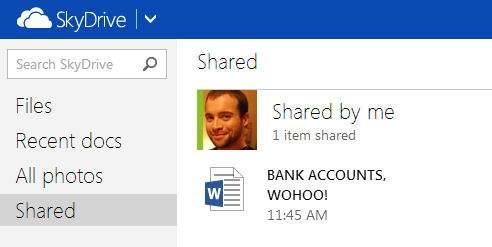It’s increasingly common to share all kinds of files through services such as DropBox, OneDrive and Drive. We post pictures on Photobucket and Imgur, upload files to MediaFire or Mega, and put music on Soundcloud. If you want to share these files, you can create a private link; anyone who receives it can use it to access these files.


If there are bugs in the app’s security, however, or if the link is shared on an open network, your data might end up in Google, which continuously scans the network for new links. If you send the private link to someone who is careless, for example, they might share the link in an email or post, which can be scanned by Google. Once its in the system, there is little you can do, except hide the files or delete them.
 A document stored in Dropbox can be accessible from Google (source)
A document stored in Dropbox can be accessible from Google (source)
File sharing isn’t something to be taken lightly: apps can make mistakes, just like people. If you want to share something with the minimum guarantee of security, follow these basic tips.
Tip 1: regularly check your shared files
It’s good to regularly review what you’re sharing. Google Drive has filters that quickly let you see public documents, or documents that have been shared via a link.

The privacy of those files can be modified with a few mouse clicks. Mark them and go to the “Share” menu.

SkyDrive (soon to be OneDrive) works in a similar way: if you click on the “Shared” menu, you’ll see all the files you’re sharing publicly or through a private link. In properties, you can then change the files back to being private.

If you’re using Dropbox, there are two sections where you can check what you’re sharing: one with folders, and one with private links. “Unsharing” is as simple as clicking on the cross which is in the box next to the file.

Tip 2: delete metadata and other sensitive information
There’s much more information contained in a file than is visible at first glance. Even after removing personal data – something that’s highly recommended – a Word DOC may contain information that can lead you to the person who created it.

Doc Scrubber eliminates metadata from Word documents
This information is called “metadata” (data about the data), and almost every file contains it: pictures, videos, music, documents– no file is immune. You can use tools like MetaStripper or Doc Scrubber to remove metadata from your files.
Tip 3: Set up Google Alerts for your personal data
If you’re worried about the possibility of information being leaked, it’s worth setting up a Google Alert. Google Alerts warn you when new results appear for a chosen piece of text. You can get the alert straight away, or after a few hours so that if one of your files has filtered into a public network, you’ll be the first to know.

With Alerts, it can be useful to include a fragment of your current account number or ID number, your full name, or your phone number. Unfortunately, Google Alerts aren’t yet able to tell you about the appearance of duplicated or plagiarized images.
Tip 4: Choose the most appropriate site for file sharing
There are an infinite number of services that let you share files on the Internet, but using Dropbox and Mega, for example, is not the same thing. The characteristics of each service determine what’s best to share through it. Some sites are best used for sharing files in a fleeting way, for example, through the use of deletion codes.

“Large files that you wouldn’t care if they were deleted? Go on then, upload to Mega…”
If you want to distribute a file in the short term and include an expiry date on it, for example, it’s best to use Mega, while for collaborative editing, it makes more sense to upload it to SkyDrive or Google Drive. The important thing is to know at all times what you’re sharing, and where.
Want security at the next level? Set some passwords
These tips will help protect you from getting into the majority of trouble that’s associated with data leaks, but you should be aware that sharing something using online methods can expose your data to all kinds of unforeseen circumstances.

Maximum security can be achieved through data encryption, or a combination of compression and encryption. If you upload an RAR 5.0 file with 256-bit encryption instead of a document that isn’t encrypted, your privacy will be more secure.
What do you do to ensure your files remain private?

